#aa sca yr 3 sem 1 week 3
Explore tagged Tumblr posts
Text
Art Studio 1 Research: Biology of Slime (IDEA 2) PART 3
PLEASE NOTE THAT THIS IS A DRAFT CONTAINING SOME SUGGESTIONS FROM LECTURERS SALOTE AND JACKY (8.3.24) AND IS THEREFORE UNFINISHED (AND WILL MOST LIKELY BE OUTDATED) AS OF ME WRITING THIS. THIS IS PURELY FOR NOTE-KEEPING.
Summary of idea 2a (drafted notes based off of consultation discussions on 4.3.24)
Title (whether it be a working title OR the overarching theme): Comfort and repulsion, Natural and unnatural
Description: My work asks many questions: "Can repulsive things also comfort us about our own biology? And at what point is something considered unnatural and why?" It aims to exist within, blur and outright break the lines between these opposing ideas.
Potential medium/s and techniques/materials:
Short film with accompanying soundscape
Alternating between live footage (mucus on creatures, 'slimy' food, plant mucilage, homemade slime?, etc.) and 2D frame-by-frame animation (biomorphic forms, dripping, sticky webs, glistening mucus, etc.)
Soundscape would include noises made with 'slimy' food/materials, homemade slime, and perhaps internal noises (similar to what I did for the soundscape in Step into my Culture) like breathing, coughing, swallowing and borborygmus.
Summary of idea 2b (drafted notes based off of consultation discussions on 4.3.24, to be reviewed 8.3.24)
Title (whether it be a working title OR the overarching theme): Embracing our Slimy Selves
Description: My work delves into the more tangible, sensory experiences of slime and biology as a whole. It invites the audience to acknowledge the conflicting feelings of disgust and comfort/intrigue, and embrace the bizarre nature of their own biology.
Potential medium/s and techniques/materials:
Interactive sculptures (glass, texture mediums, etc.) to 'model' slime and other organic shapes
Texture mediums to use: impasto gel, modelling paste, and (perhaps mix these with dyes instead of paint for a translucent effect in gel)
Perhaps combine glass and textured mediums?
8.3.24 (suggested by Jacky Redgate): What about no visuals (dark space perhaps, purely touch)?
8.3.24 (suggested by Jacky Redgate): Why not look into the term 'anti-form'?
0 notes
Text
Art Studio 1 Research: Soundscape Ecology (IDEA 1) PART 3
PLEASE NOTE THAT THIS IS A DRAFT CONTAINING SOME SUGGESTIONS FROM LECTURERS SALOTE AND JACKY (8.3.24) AND IS THEREFORE UNFINISHED (AND WILL MOST LIKELY BE OUTDATED) AS OF ME WRITING THIS. THIS IS PURELY FOR NOTE-KEEPING.
Summary of idea (drafted notes inspired by consultation discussions on 4.3.24, to be reviewed 8.3.24)
Title (whether it be a working title OR the overarching prompt/theme): Sounds in an Empty Space
Description:
Short: My work focuses our complex relationship to sounds in our environment. I want to invite the audience to recognise this relationship.
Longer: I was inspired by Gabriel Garcia-Marquez's short story, A Man with Enormous Wings. Whether it be the angel's foreign language, the sounds of the town, and how various characters (including the angel himself) are afflicted with strange conditions involving sounds - sound seems to underpin part of the story.
As such, I want to create an aural/visual experience, where the audience - the 'outsiders' here - is enlightened and confronted by a multilayered soundscape in the darkness: sometimes harmonious, sometimes conflicting. The soundscape is formed by "multiple dialects interacting into some strange musical language" (potentially manifesting as abstract 'physical' forms).
Potential medium/s and techniques/materials:
Primarily sound-orientated
Biophonic field recordings (animal calls/sounds), via a zoom recorder (or a hydrophonic microphone?), are edited into a soundscape (Adobe Audition).
Each soundscape may be split into segments - for example, rainbow lorikeets, bream, etc.
The field recordings could also have anthropohony (vehicles, people walking/swimming, etc.) in the background.
Perhaps I could have anthropophony in some other form for the soundscape: 'makeshift music' (created using various objects or gestures done by me) or imperfect, spontaneous choirs (composed of various sounds made by the body - consciously and unconsciously, using my voice, hands, etc.)?
An orchestra of 'calls' that can blur the line between biophony and anthropophony, while creating an entirely new 'language' or 'composition'.
Perhaps within the pitch-black of the installation room (where the sound will play), what about periodically having 'animated silhouettes' (similar vein to the animated bacteria in Step Into my Culture) of some of the animals and of people?
Those colourful 'silhouettes' could be projected onto simplistic paper cut-outs (or more 3D sculptures) of the animals - abstract pairing?
The only references to people in this work are the anthropophony in the soundscape and the audience ('outsiders') within the installation.
8.3.24 (suggested by Salote Tawale): What about using contact mics for feedback sounds made by the audience's motions?
8.3.24 (suggested by Salote Tawale): Perhaps no visual things?
0 notes
Text
Art Studio 1 Research: Biology of Slime (IDEA 2) PART 2
Artist Archive (both ideas): Markos Kay's aBioGenesis (2022)
aBioGenesis (2022, CGI-animated short film (57 secs))
vimeo
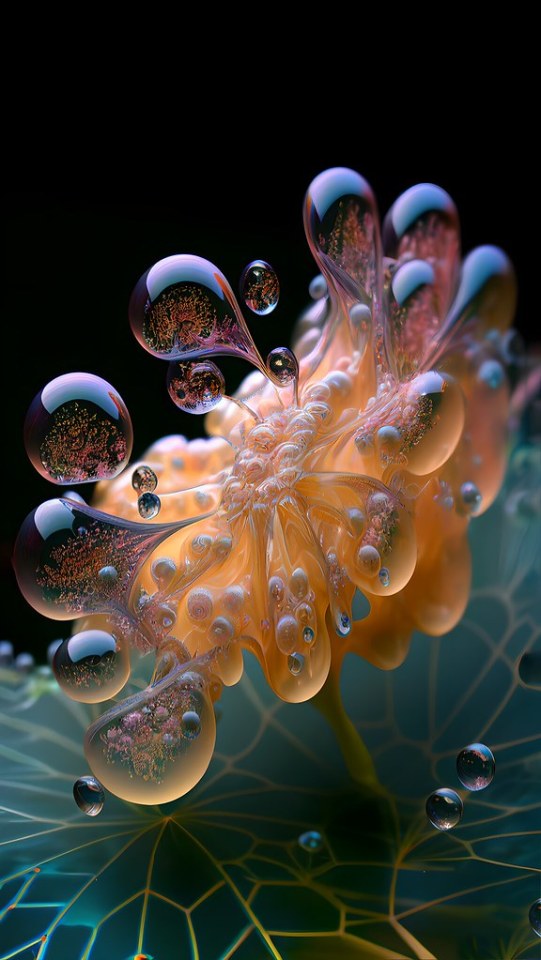

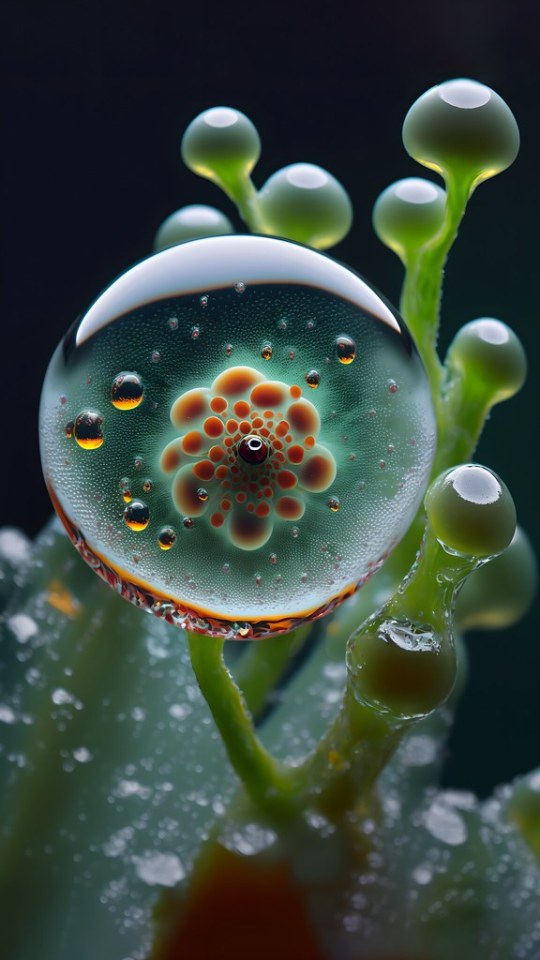
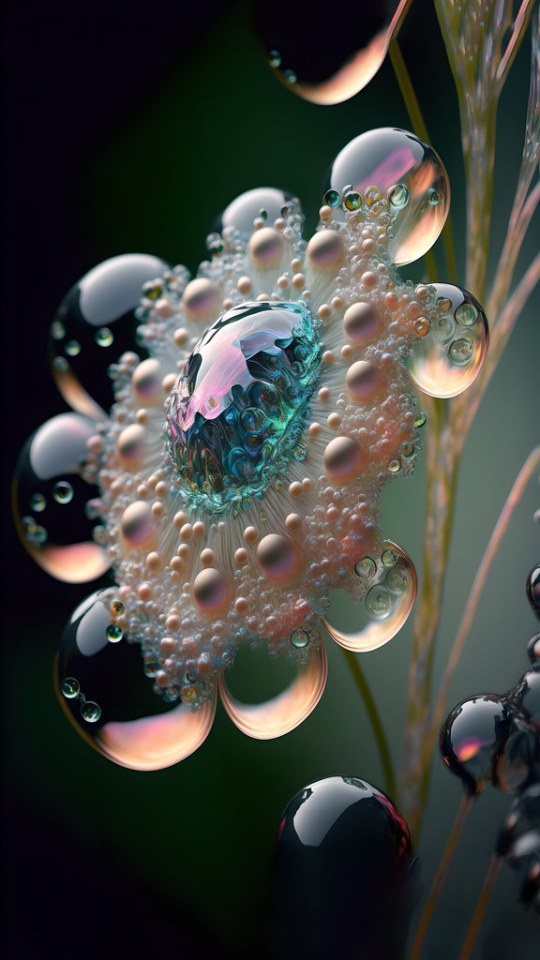
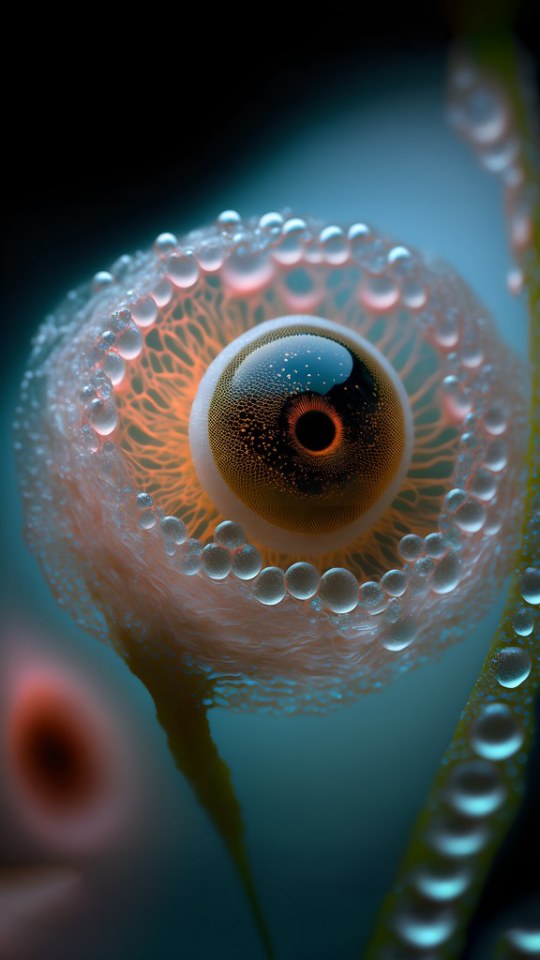

Markos Kay's works exist in between art and biology, in this case creating a visual 'reimagining' of the theory that early cellular life originated from 'primordial lipids'.
Organic forms (droplets, bubbles, vesicles/vacuoles, veins, flowers, cells, etc.) could perhaps influence how my 'slime-inspired work' may look (abstract?).
Abstract/biomorphic animation is definitely something I may use for my own work.
Artist Archive (both ideas, but primarily idea 2a): Aron Sanchez-Baranda
1st Row (left to right) - photographic prints: Fundament, Pisaster ochraceus/Anthopleura xanthogrammica (2021), Hair, Gum and Blood, Stemonitis sp. (2019), Febrile, Urticina eques (2021)
2nd Row (left to right) - short film screencaps: Take me to your heart, Phoca vitulina birth remnants (2017), Higher class tissue, Octopus rubescens (2021), Proportion dependent, Anthopluera sola (2023)
3rd Row (left to right) - short film screencaps: Cell wall, Aplysia californica (2023), World entire, Anthopluera sola (2023), Transactive memory, Anthopluera sola under UV light (2022)
4th Row (left to right) - short film screencaps: Lap, Neverita lewisii (2021), Cooperation offer, Ophiodromus pugettenis lives within patiria miniata (2022), Sparkling reflective stacks of purine crystals, Flabellinopsis iodinea (2023)
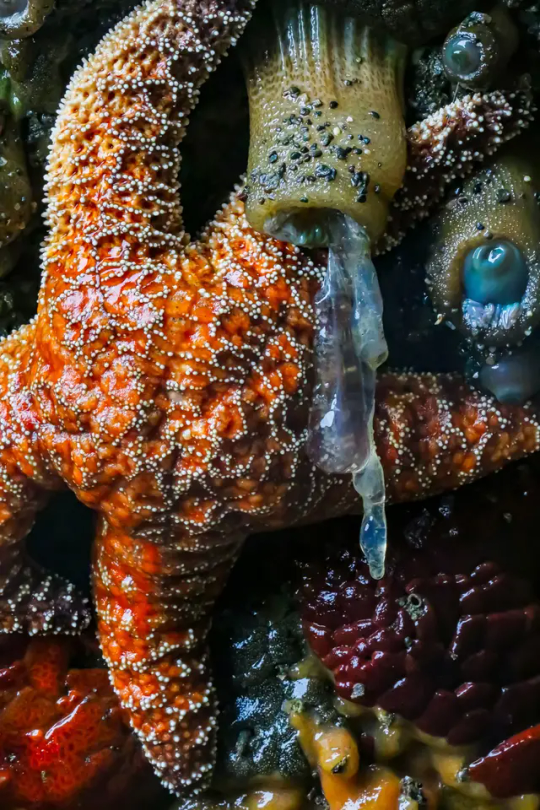
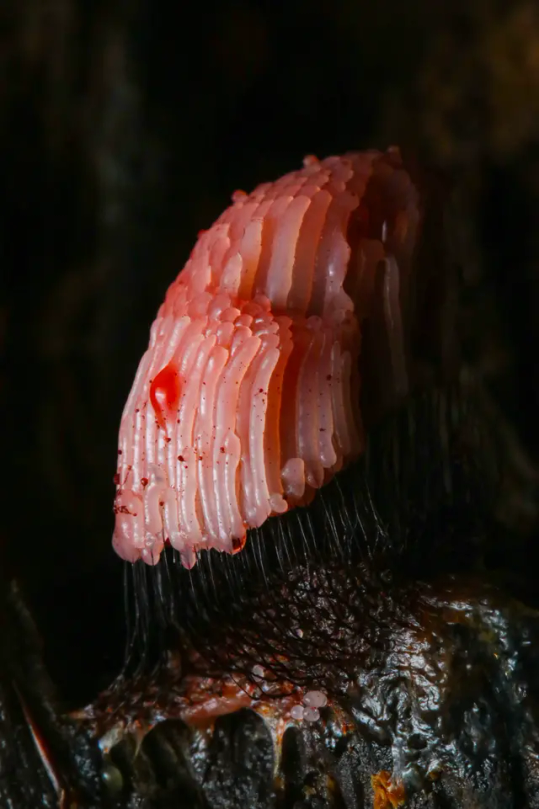


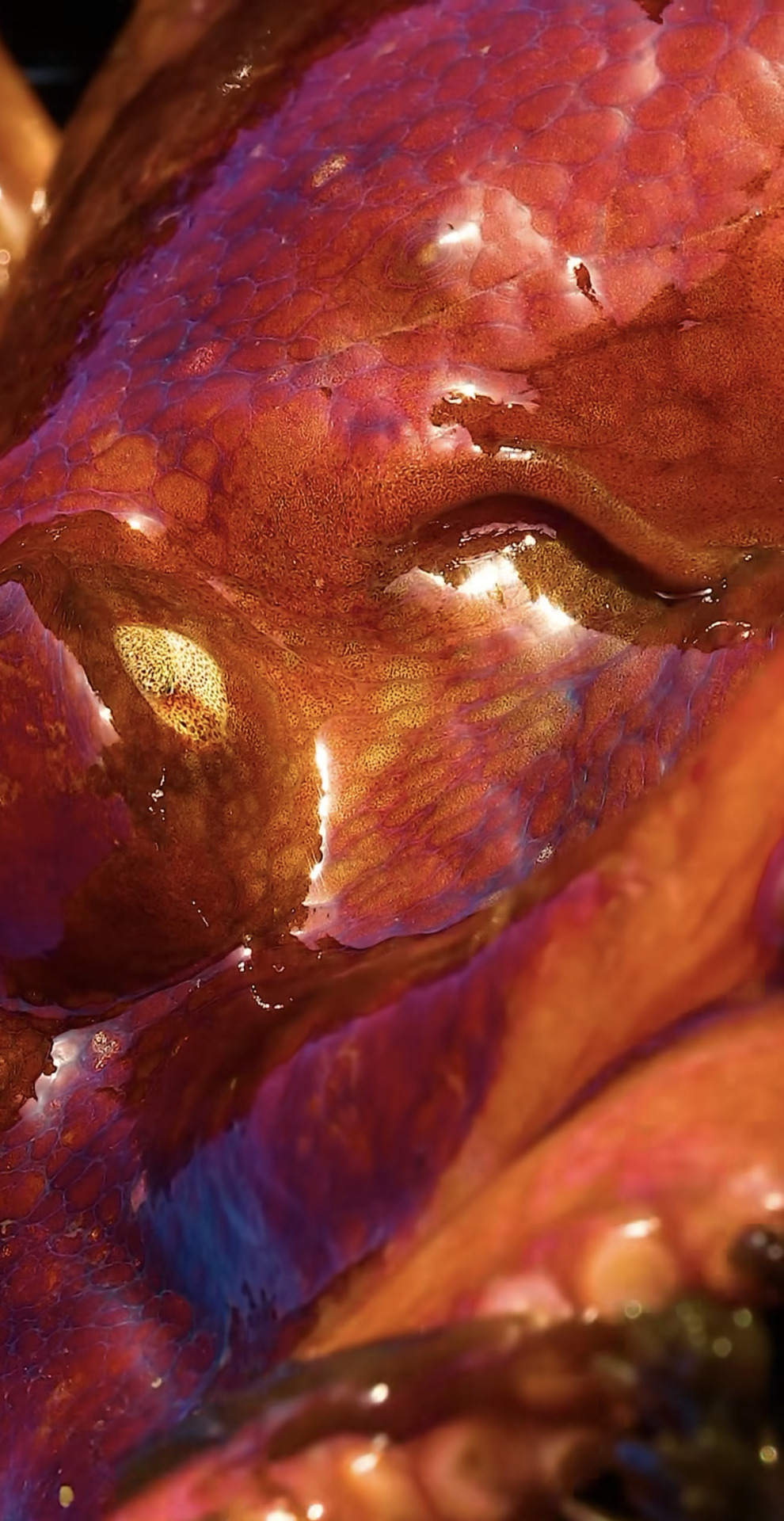




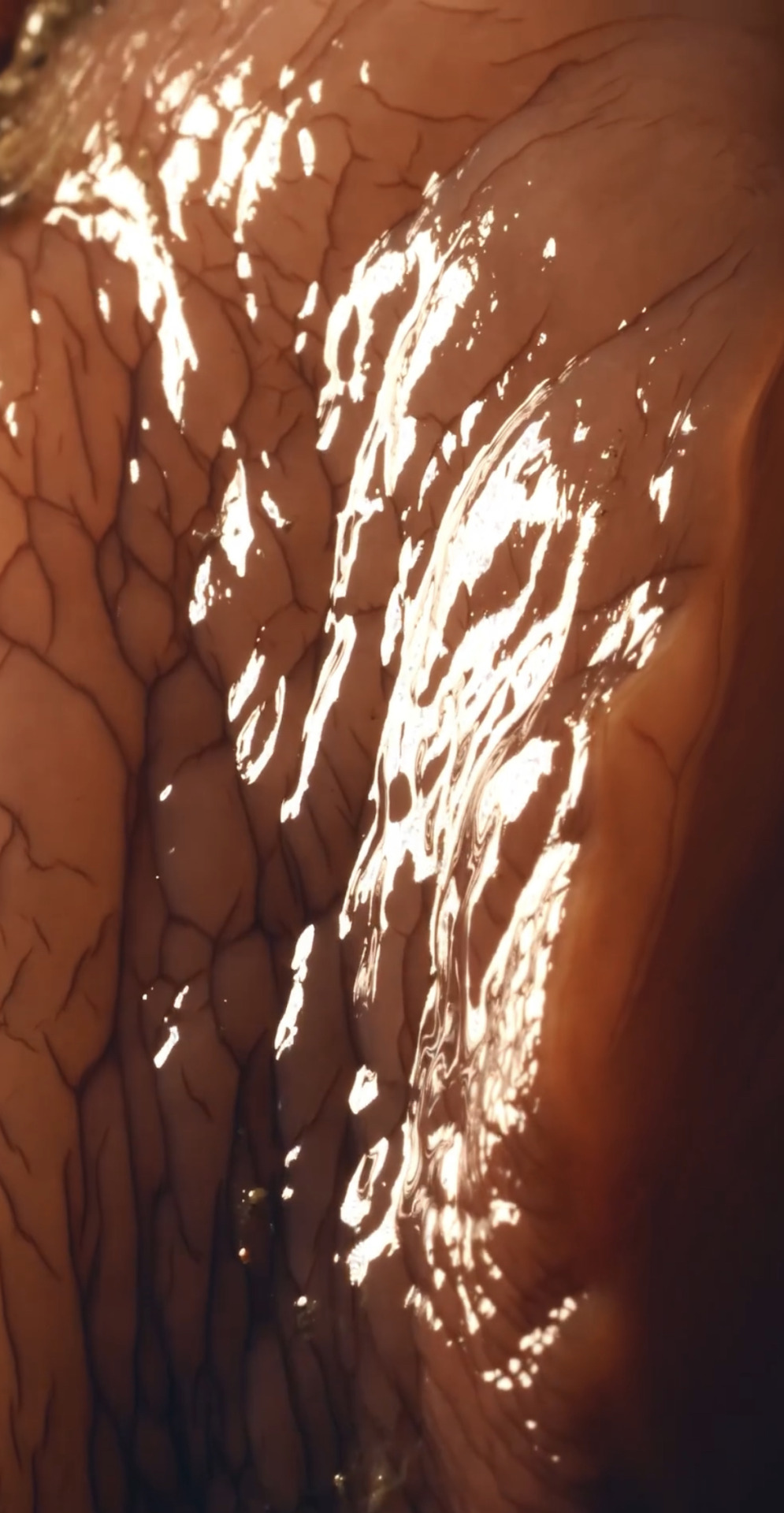


Aron Sanchez-Baranda's photographs and films exist as both documentation and art.
His close-ups of fungi and marine wildlife abstract the natural forms of the subject, focusing on the colours, the patterns, the shapes and textures interacting with each other, and the glistening water, mucus, etc. of their surfaces.
This may perhaps play into the natural vs. unnatural, familiar/comfortable vs. repulsive?
Artist Archive (both ideas, but primarily idea 2b): Anicka Yi's tempura-fried flower sculptures and artificial honeycomb lamps
1st Row (left to right): Maybe She's Born With It (2015), ALZ/AZN (2015), Lapidary Tea Slave (2015)
2st Row - tempura-fried flower sculptures: Installation shot of all three sculptures listed about


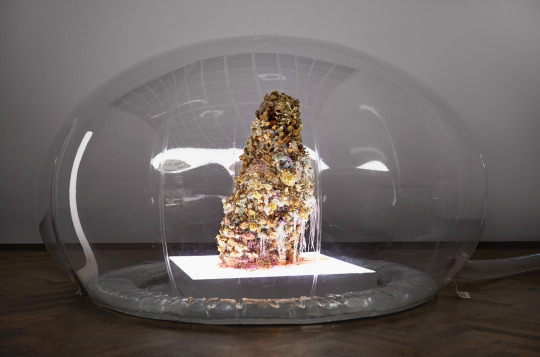
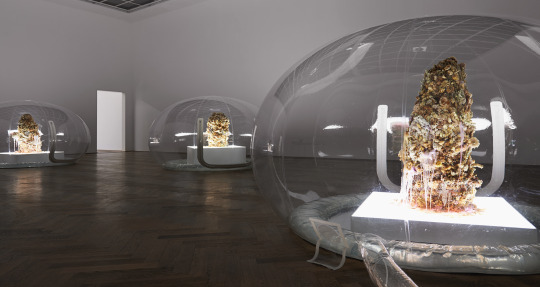
1st Row (left to right) - artificial honeycomb (epoxy resin) lamps: Escape From The Shade 1 (2016), Escape From The Shade 7 (2016), God Make It This Time Or Never At All (2017)
2nd Row (left to right) - artificial honeycomb (epoxy resin) lamps: Mausoleum Of Easy Going (2017), Slippage Between Law and Art (2022), One Bright Pearl (2022)
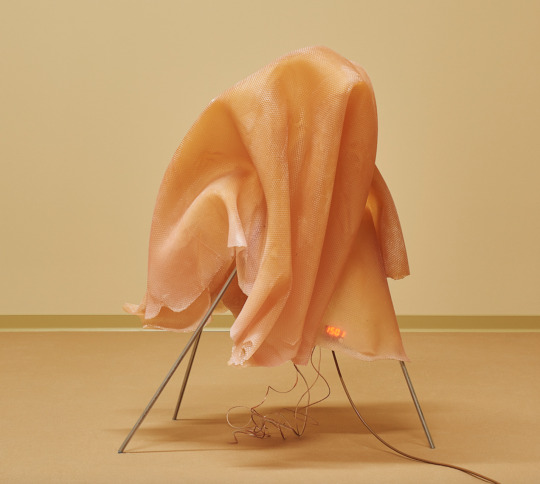
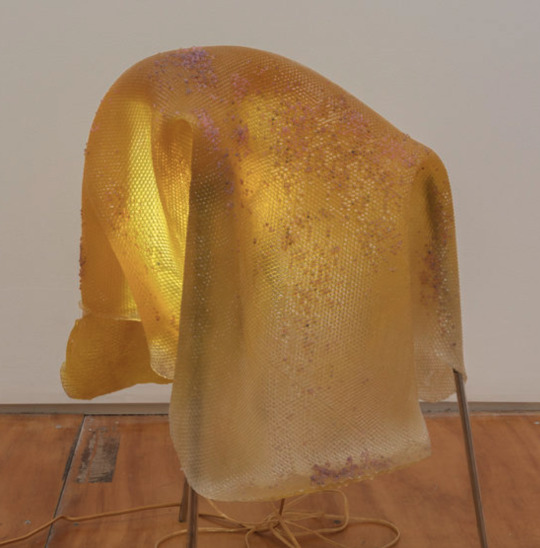
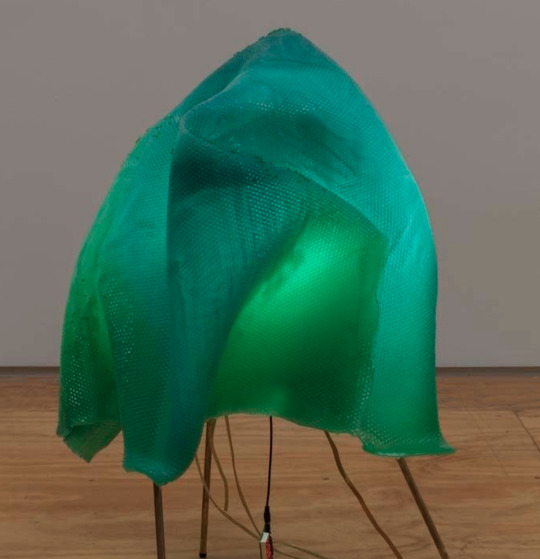
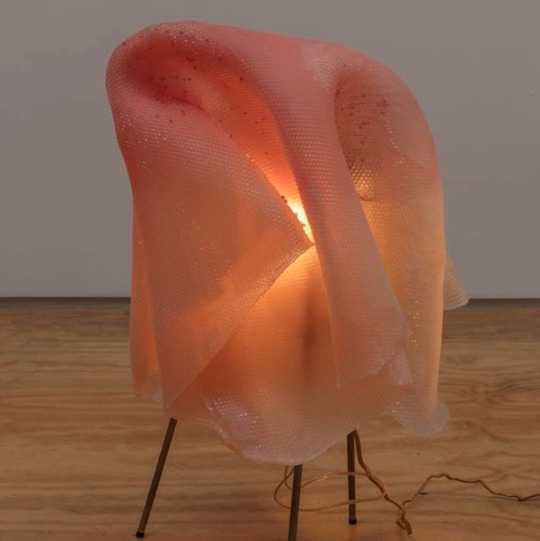
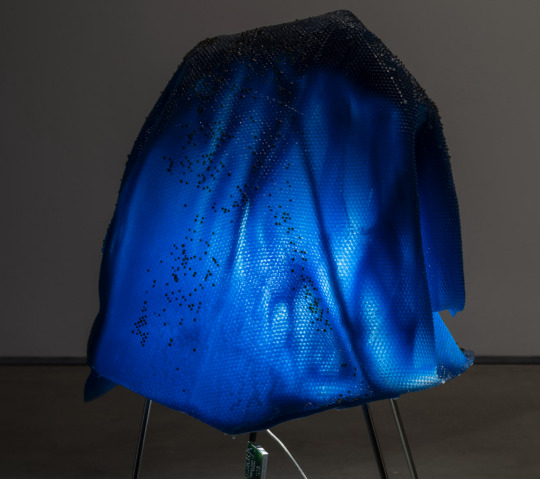

Anicka Yi is another artist who explores biology and art, but more within the context of sensory immersion and how it may trigger emotional responses.
In the case of her tempura-fried flower sculptures, the strong smell of oil, tempura batter and decaying plants exudes from a hybrid between crystallised and molten/dripping forms (interesting to play with both shape/texture and smell).
As for her artificial honeycomb lamps, she transforms the 'honeycomb' into a 'draping cloth' while maintaining its texture and translucency - with colours ranging from softer and more natural to more vibrant and emotive (perhaps textured sculptures and light/colour for a tangible, interactive form?).
0 notes
Text
Art Studio 1 Research: Soundscape Ecology (IDEA 1) PART 2
Artist Archive: Bernie Krause's The Great Animal Orchestra (2022) (in collaboration with United Visual Artists)
The Great Animal Orchestra (2022, sound and film installation - visualisations formed by sound spectrograms and colour graphics)
youtube







Bernie Krause studies soundscape ecology (see previous notes), inspired to showcase the importance of sound in assessing the natural environment - prior to this, he created sound for various films.
Composed of field recordings from ~15,000 land and marine species, the sound installation visualises soundscapes (via spectrograms) from the Brazilian Amazon to the Californian Coast.
Is the visual important for my primarily sound-oriented work, or could it be absent in favour of other senses??
Below is an interview with Krause during the 2022 Sydney Biennale:
youtube
Artist Archive: Jónsi's Hrafntinna (Obsidian) (2021)
Hrafntinna (Obsidian) (2021, sound installation with subwoofers, speakers, circular light chandelier, and fossilised amber scent (25 mins 33 secs))
youtube



An Icelandic musician, Jónsi creates a bridge between the aural realms of the human experience and our connection to nature.
He combines both geophony (seismic rumbling, lava spills and grinding rocks) and anthropophony (music and Icelandic choir songs) into the volcanic soundscape.
Deprivation of sight (except for light/dark and the subwoofers), instead playing with sound (detailed above) and scent (fossilised amber).
Artist Archive: Sonia Falcone's Windows of the Soul II (2010)
Windows of the Soul II (2010, sound and film installation - colour film projected onto pillars)
youtube









As a Bolivian artist, culture, colour and spiritualism influence Sonia Falcone's works - usually as visual metaphors or symbols.
By combining music and sculptures with ever-changing film projections, she portrays the 'soul' as many things: organic and inorganic, expansive and microscopic, external and internal, multiple or singular.
The film projections 'move' on the uneven pillars - perhaps to create a moving segmented performance within the dark?
0 notes
Text
Art Studio 1 Research: Biology of Slime (IDEA 2) PART 1
Properties of slime
Most slimes in organisms are aqueous hydrogels. However, not all slimes are hydrogels and not all hydrogels are slimy.
Aqueous hydrogels = substances where water trapped in a 3D polymer network.
Therefore, it is important to know that the primary characteristic of slimes is:
Viscoelasticity: the quality of having both viscosity and elasticity, "uniting the properties of liquids and solids" and enabling it to change its properties (Wedlich, 2022).
This gives slime its many functions in living organisms: lubricants, adhesives, protection (e.g. acting as a 'semi-permeable membrane' to filter out particles, and catching pathogens), communication, self-defence (physical or chemical), dispersal of reproductive material, etc. The slimes in living organisms contain glycoproteins such as mucins.
Why is slime so important for life (including in humans)?
As alluded to previously, slime has a number of different purposes. These purposes include:
Adhesion (for movement or catching food)
Lubrication (for movement)
Protection and self-defence
Dispersal
Adhesion and lubrication:
Movement of gastropods (sea slugs, land/cone snails, etc.): Two purposes of gastropod mucus are adhesion for climbing up vertical surfaces and to prevent being blown away by powerful wind/water currents, and lubrication to move across surfaces with ease.
Mucus in the digestive tract (oesophagus and intestines): Facilitates movement of food through the gut.
Mucus in creatures such as pelagic snails ('slime nets') and sundew plants (mucilage): Helps to collect food (adhesion).
Protection and self-defence:
Mucus in the respiratory tract: Filters and collects pathogens and other debris, which is carried out the lungs.
Mucus in the stomach: Protects the inner lining from acid.
Parrotfish and hagfish: Both use mucus to protect themselves from predators - the parrotfish to 'hide' its scent from predators while it sleeps and the hagfish to clog the throat/gills of a predator so it can escape.
Mucus on certain nudibranchs: Protects their bodies from the stings of some of the anemone/jellyfish nematocysts they eat.
Mucus on various amphibious/aquatic creatures (frogs, cephalopods, etc.): Prevent their skin drying out, and in some species to facilitate additional gas exchange through the skin (frogs and squid).
Dispersal:
Mistletoe berries: Sticky, viscous flesh that carry the seeds, which are excreted by the birds that eat them (they are also toxic to humans and most other animals = additional function of self-defence).
Stinkhorn fungi: Gleba, a gelatinous, sticky substance covering the fruiting body of the fungus, carries the spores needed to reproduce - insects like flies eat the gleba and help distribute the spores now attached to their bodies.
It has also been found that not only are gelatinous/'slimy' organisms integral parts of the marine food web (siphonophores (predators) and jellyfish (predators/prey)), but there have been theories that the earliest organisms may have originated from a 'primordial slime'.
Why slime and disgust?
Throughout the history of literature and other media (particularly horror and/or science fiction), slime/mucus has been depicted as 'disgusting', 'alien' or 'monstrous' rather than a natural (and integral) part of biology. Examples of such portrayals include H.P Lovecraft's At the Mountain of Madness (1931) and the 1988 film The Blob.
As Susanne Wedlich details in the book Slime: A Natural History, this perception was grounded in many social and political biases/prejudices throughout history (as shown in historical writings):
The vilification of various marginalised groups: In this case, particularly women and LGBTQ+ people (however, works like The Blob were inspired by global tensions and political panic during the Cold War).
The fear of death, disease and decomposition: This stems from the fear of confronting our own mortality.
The perception of anything biological (particularly in women/AFAB people) as 'taboo': For example, sexuality as 'animalistic', childbirth as 'grotesque' and menopause/ageing as 'undesirable/ugly'.
Martha C. Nussbaum reinforces this notion in her 2018 opinion piece: "Human beings are probably hard-wired to find signs of their mortality and animality disgusting, and to shrink from contamination by bodily fluids and blood. But in every culture something worse kicks in: the projection of these feared and loathed characteristics... onto a vulnerable group or groups from whom the dominant group wishes to distance itself [from]."
Wedlich also presents instances where people (especially women) in history reclaimed 'slime' (and anything else in their biology that was seen as disgusting) as a form of empowerment. For example, American writer Patricia Highsmith loved observing and breeding/keeping snails, even going on several trips to smuggle them across the French border when she moved from London. Fiona Peters (Professor of crime fiction) argues that snails were present as themes within Highsmith's works: "transgressive feminine sexuality", identity ('the self and the other'), and sapphic*/lesbian relationships (Highsmith was a lesbian herself).
(*NOTE: 'Sapphic' refers to women/gender-diverse people who are attracted to women. While 'lesbian' (women/gender-diverse people primarily or exclusively attracted to women) does align with the umbrella definition of 'sapphic', so do other sexualities like 'bisexual' (attraction to two or more genders, with or without a preference) and 'pansexual' (attraction to people regardless of gender).)
There is also media that directly subvert the 'slime = disgust' trope. On one hand, some works may portray mucus as a beautiful, mysterious part of the landscape (the gelatinous 'alien ocean' in Stanisław Lem's Solaris (1961)). Others may use it as a basis for empathy towards historically-marginalised groups, and for criticising the discrimination/exploitation of these groups (the titular creatures in Karel Čapek's War with the Newts (1936)).
While many perceptions of historically-marginalised groups have changed since then, the association of slime with disgust still persists. In his article Corporeality, hyper-consciousness, and the Anthropocene ecoGothic: slime and ecophobia, Simon C. Estok discusses the following term in relation to slime and disgust:
Ecophobia: The fear, aversion or ethical dismissal/devaluing of the natural world, its importance, and the issues that impact it.
With this in mind, you could argue that disgust towards slime/mucus as a whole (even without the social biases) may be considered a form of biophobia.
Biophobia: The fear/aversion towards anything biological (living organisms, one's internal biology, etc.), typically stemming from a disconnect with nature.
Below is a TED Talk by David Pizarro. While the methodology of the study discussed (its accuracy and potential bias) is debated, it does further explain the connections between societal/political perceptions and the disgust response.
youtube
Interesting note: Dualities
In my research, multiple dualities have been observed here:
Beauty and disgust
Appreciation and repulsion
Familiar and 'alien'
Tangible and abstract
Understood and unexplained
Health and sickness
Open-minded and closed-minded
The comfortable and the 'abject'
Self and other
Us and them
Compassion and hostility
Life and death
Natural and 'unnatural'
Acceptable and taboo
Perhaps a few of those can be the basis of my work.
References
Bansil, Rama, and Bradley S. Turner. “The Biology of Mucus: Composition, synthesis and organisation.” Advanced Drug Delivery Reviews 124, no. 1 (January 2018): 3-15.
Brownworth, Victoria A. “Patricia Highsmith: A Lesbian Life in Diaries.” Philadelphia Gay News. Published December 9, 2021. https://epgn.com/2021/12/09/patricia-highsmith-a-lesbian-life-in-diaries/
Estok, Simon C. “Corporeality, hyper‐consciousness, and the Anthropocene ecoGothic: slime and ecophobia.” Neohelicon (Budapest) 47, no. 1 (June 2020): 27-36.
McShane, Abigail, Jade Bath, Ana M. Jaramillo, Caroline Ridley, Agnes A. Walsh, Christopher M. Evans, David J. Thornton, and Katharina Ribbeck. “Mucus.” Current Biology 31, no. 15 (August 2021): 1-7.
Greenwood, Paul G., Kyle Garry, April Hunter, and Miranda Jennings. “Adaptable Defense: A Nudibranch Mucus Inhibits Nematocyst Discharge and Changes With Prey Type.” The Biological Bulletin 206, no. 2 (April 2004): 113-120.
TED Ed. “The Strange Politics of Disgust - David Pizarro.” Published April 9, 2013. YouTube video, 14:02. https://www.youtube.com/watch?v=pqX9zMuKENc
Wedlich, Susanne. Slime: A Natural History. London: Granta Books, 2022.
Ze Frank. “True Facts: Stinkhorns.” Published November 21, 2019. YouTube video, 3:38. https://www.youtube.com/watch?v=ADrBo7u3tR4
0 notes
Text
Art Studio 1 Research: Soundscape Ecology (IDEA 1) PART 1
What is soundscape ecology?
Soundscape ecology: The study of sounds, particularly in the interactions occurring within landscapes (natural, built, internal, etc.).
This term is considered under the umbrella term of sensory ecology (using your senses to understand the interactions occurring within landscapes).
While it is important to see what happens and changes in the world (particularly in ecological landscapes), it is equally important to listen.
Categories of soundscape ecology
Soundscape ecologist Bernie Krause proposed 3 different 'sound categories' to consider:
Biophony
Geophony
Anthropophony
In his book, A Book of Noises: Notes on the Auraculous, Caspar Henderson proposed a fourth one: Cosmophony.
Below is a summary of what each category entails (in the order they are described in Henderson's book):
Cosmophony: Sounds made by space (planets, stars, etc.).
Geophony: Sounds made by non-biological, natural phenomenon (wind, water, rocks, weather, etc.).
Biophony: Sounds made by living organisms except for humans.
Anthropophony: Sounds made by humans.
What constitutes biophony?
Biophony focuses on non-human organisms.
This can encompass things including, but aren't limited to:
Animal calls
Other sounds of the body (heartbeat, breathing, borborygmus, etc.), which can indicate health or sickness
Movement (walking, flying and swimming)
Electrical signals produced by plants/fungi, which can be converted into sound
In the natural world, sounds are just as important as visual indicators in investigating environmental changes.
In the case of animal calls, they do share a similar function to different forms (spoken language, vocalisations, music/singing) of anthropophony: communication. Here are some examples:
Songbirds (Interestingly, they evolved from a common ancestor in Australia.)
Other birds (parrots, finches, hummingbirds, magpies, etc.)
Sea creatures (Due to travelling faster through water than air, sound is used to communicate or help them to find food (whales, fish, seals, crustaceans, etc.).)
Insects (cicadas, bees, crickets, grasshoppers, etc.)
Bats
Frogs
As one of the stories (of the beaver father - see video below), animals can be just as capable as humans of emotional expression through sounds.
Below is a 2013 Ted Talk by Bernie Krause, which elaborates on the importance of biophony (both in the natural world and as an emotional/sensory experience):
youtube
What constitutes anthropophony?
Anthropophony concerns any and all sounds produced by humans.
While many think of music and singing, other forms of anthropohony include, but aren't limited to:
Spoken language and other kinds of vocalisations
Other sounds of the body (heartbeat, breathing, borborygmus, etc.), which can indicate health or sickness
Machines and other technology (cars/trains, boats, factory machines, computers, power tools, etc.), which are responsible for noise pollution
Poetry and other forms of literature have integrated sound into writing. One example of this is Bashō's haiku, which reflect the sounds and sights of the natural world.
Music encompasses both physical (acoustic instruments, etc.) and digital (synths, etc.) instruments.
Interesting note: Gabriel Garcia Marquez's 'A Man with Enormous Wings' (as detailed in Henderson's book)
This short story is about an angel who falls to earth, landing into a small Columbian town. Not only is he an outsider/foreigner, but he proves to be a source of curiosity (for better or for worse).
Some of the townspeople turn to the angel for help with their bizarre ailments: from a woman losing count of her heartbeats to a man who can't sleep due to constantly hearing the sounds of stars.
The angel himself has some oddities too. This becomes apparent when the local doctor hears whistling inside the angel's chest instead of a heartbeat, wondering how the angel is still alive.
In relation to sound, this story has three things:
An outsider in a new environment = new perspective?
An outsider listening to the sounds around them, both in the town and from the plights of the townsfolk.
An outsider additionally forced to confront the strangeness of their own sounds ('foreign language', 'heart-whistling', etc.).
Perhaps I could incorporate that into concepts for my work?
References
BirdLife Oz. “Bird Finder: Top 40 bird songs.” Birds in Backyards. Accessed March 1, 2024. https://www.birdsinbackyards.net/birds/featured/Top-40-Bird-Songs
Henderson, Caspar. A Book of Noises: Notes on the Auraculous. London: Granta Books, 2023.
Joseph, Leo. “The Sweet Hum of Songbirds.” CSIRO. Published September 10, 2021. https://www.csiro.au/en/news/All/Articles/2021/September/evolution-songbirds
Krause, Bernie. Voices of the Wild: Animal Songs, Human Din, and the Call to save Natural Soundscapes. London: Yale University Press, 2015.
Pijanowski, Bryan C., Luis J. Villanueva-Rivera, Sarah L. Dumyahn, Almo Farina, Bernie Krause, Brian M. Napoletano, Stuart H. Gage, and Nadia Pieretti. “Soundscape Ecology: The Science of Sound in the Landscape.” BioScience 61, no. 3 (March 2011): 203-216.
Ocean X Media. “Fish Sounds: Do fish talk to each other?.” Published April 6, 2018. YouTube video, 6:46. https://www.youtube.com/watch?v=POITH02VVrw
TED Ed. “Bernie Krause: The Voice of the Natural World.” Published July 16, 2013. YouTube video, 14:48. https://www.youtube.com/watch?v=uTbA-mxo858
0 notes
Text
Art Studio 2 Experimentation: Adding to last semester's Ableton soundbank PART 1 (2.8.24)
NOTES
Based on the feedback (see previous post), more Ableton sounds and field audio recordings are needed to further explore the potential for sound/soundscapes (perhaps to create a more cohesive/refined, reflective narrative).
In light of certain ideas and feedback (e.g. further exploration of sound, and potential inclusion of "interactive/acoustic" sculptures - see previous post), perhaps I could give a calmer, more drawn-out "echoing" to the soundscape.
I used Ableton (program) synced to a MIDI keyboard controller (model = A-88MKII).
Reflection: The "Air of Dread" and "Scream Shim Pad" were too shrill/harsh and discomforting for the potential effect I had in mind. The other instrumentals seem to reflect the "reflective/echoing" idea the best, especially "Casino Blips" and "Sandman Pad".



AUDIO FILES
#sca projects#year 3 art studio project 2#sound mixing#ableton#aa sca yr 3 sem 2 week 1#aa sound work#sca usyd new contemporaries grad show
0 notes
Text
Art Studio 2 Research: Potential inspiration for the additional sculptures
Jane Gavan and Jacky Redgate's feedback on Organic Space: "Well done, superb sound work! The visual imagery was poetic - theoretical underpinnings tremendous and outstanding commitment. A great research project and methodology around the subject of soundscape ecology and engaging with fieldwork and trips. The final chosen looped 3 sequences are still being realised but can be refined in Semester 2. The direction is for shorter experiential 'narrative sequence'. The sounds of the body is the last one yet unrealised. There is a lot to explore and develop how you will install your work for Semester 2, including sculptural possibilities, which wasn't realised yet in Semester 1. Push the sculptural and installation potential of your work. All the best for Semester 2! Jacky and Jane"
My thoughts from the feedback:
What about sculptures that can be interacted with to 'make sound'? (Perhaps leading the audience into the main exhibition room) - This will be addressed in this post and in future documentation.
Colours and shapes could mirror some of the animated forms/textures in the short film (and maybe other things in nature). - This will also be addressed in this post and in future documentation.
The soundscape in the 'terrestrial segment' of the short film needs to be explored/refined further, as does the overall installation and narrative sequence. - This will be addressed in future documentation.
Huaco Silbador (the Peruvian whistling vessel)
Created by various cultural groups in Peru from 500BCE to the 1500s.
The vessels were modelled after birds, other animals, or people.
Two different types: one that is single-chambered and another that is double-chambered.
You could either blow into it (both single-chambered and double-chambered) or fill it with water and tilt it back and forth (double-chambered). Both actions are demonstrated in the videos and diagrams below.
IDEA 1: Sculptures resembling the appearance of the environments/creatures making the sounds.
IDEA 2: Hollow interior to produce the sound?
youtube
youtube


Row 1: Ceramic whistling bottle - Muscovy (date unknown, AMNH Collection), Whistling bottle depicting maize deity (900-1400CE, National Museum of the American Indian)
Row 2: Double whistling bottle with jaguar figure (100-700CE, National Museum of the American Indian), Double-chambered ceramic whistling vessel - camelid/llama (date unknown, Smithonian National Museum of Natural History)
Row 3: Double-chambered ceramic whistling vessel - macaw with fruit (200BCE-600CE, Museo Larco)
Row 4: Monkey ceramic whistling bottle (200BCE-600CE, Museo Larco)
Row 5: Jaguar Whistling Jar (500-900CE, The Met Collection)
Row 6: Whistling Jar (200BCE-600CE, The Met Collection), Double-bodied ceramic whistling bottle - bat and spondylus shell (date unknown, AMNH Collection)
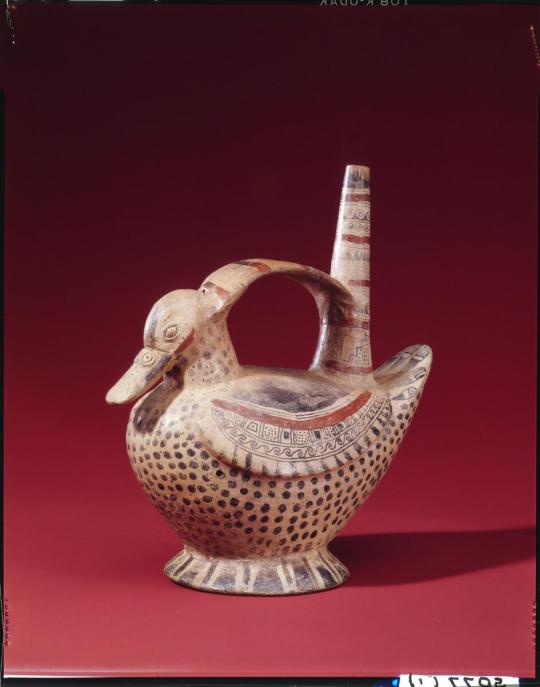

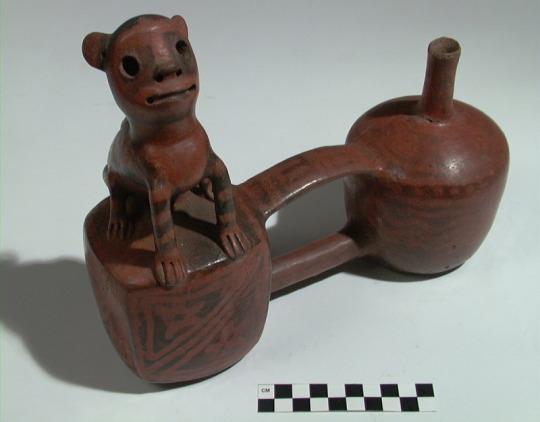
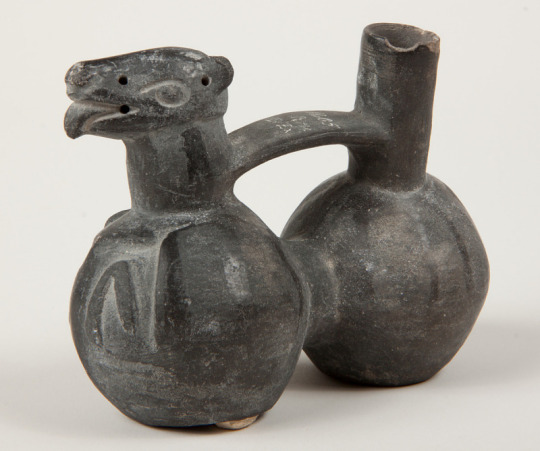

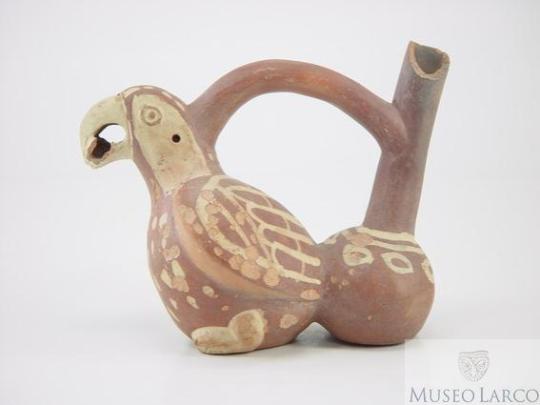
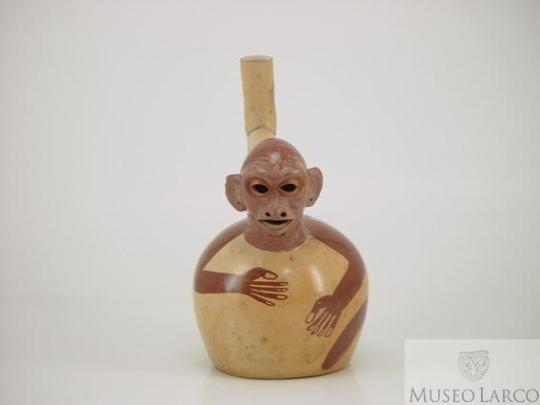
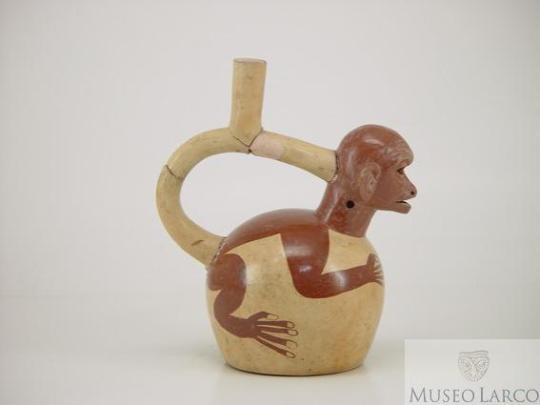
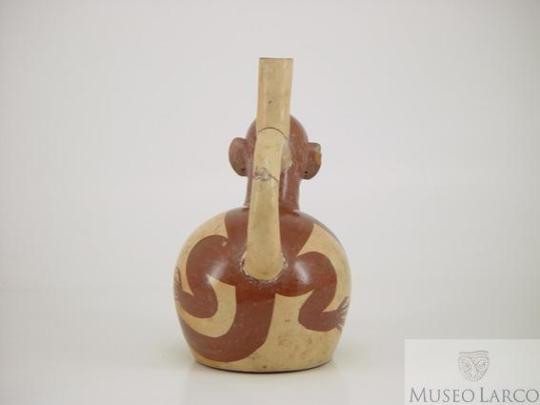
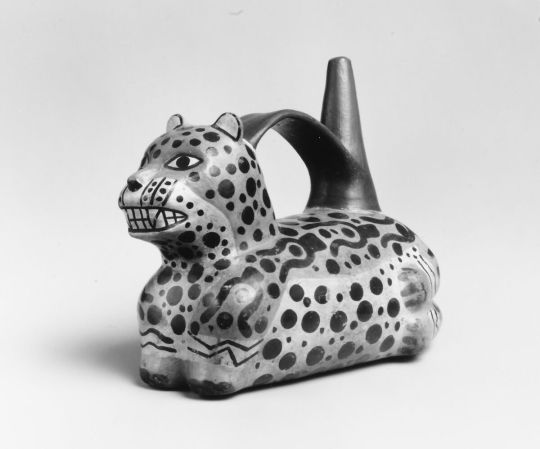
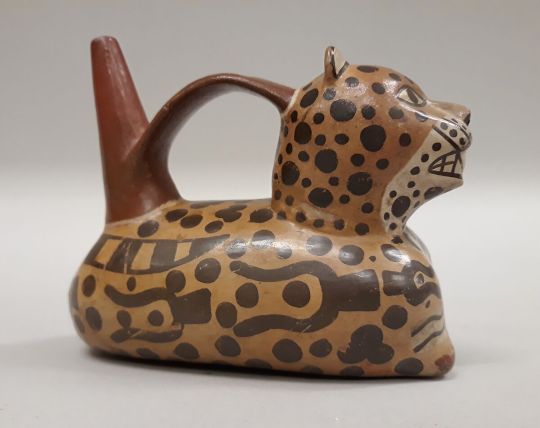
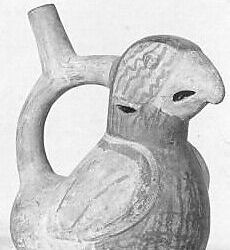
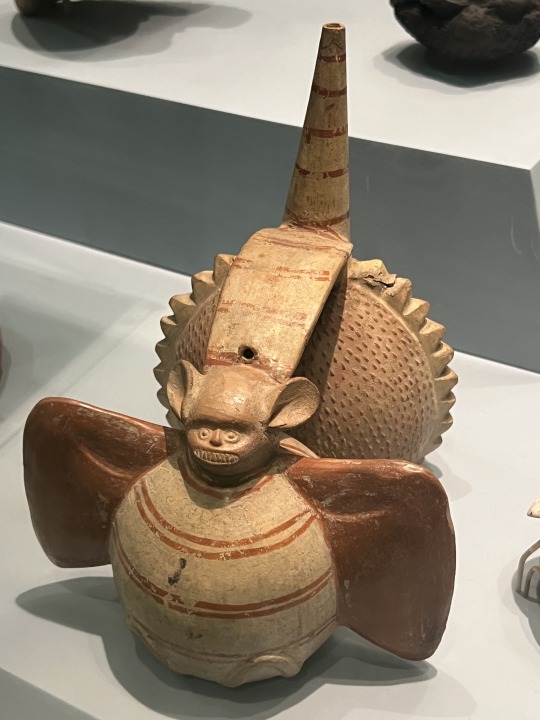
Artist Archive: Healing sound baths in Guadalupe Maravilla's body-of-work exhibition Luz y fuerza (2021)
Exhibition descriptions (from MOMA's website): ""I create new mythologies that take the form of real and fictionalised rituals based on my own lived experiences," says Guadalupe Maravilla. Two events from the artist’s life animate his work most of all: emigrating from his native El Salvador to the United States as an unaccompanied, undocumented eight-year-old and, later, surviving cancer. From this personal history grows a multidisciplinary practice that addresses trauma, contagion, rehabilitation, and rebirth.
This gallery—whose Spanish title translates as "hope and strength"—features works inspired by Mesoamerican myths and Salvadoran traditions. The sculptures are made from natural materials and ready-made objects selected for their therapeutic, historical, symbolic, and aesthetic properties. Maravilla sees them as healing instruments he can activate—and often does, especially for people experiencing illness and other hardships.
Disease Thrower #5 is a sculpture, a shrine, a wearable headdress, and an acoustic instrument. Like all works in the Disease Thrower series, it is, according to the artist, a "healing machine," which can be activated to create a sound bath with curative potential. It is made from both natural materials, such as straw and loofah, and man-made objects that Maravilla collected while retracing parts of the migratory route from El Salvador to the United States he took as a child. The work also includes anatomical models: one of a breast, another of a malignant tumour.
While undergoing treatment for cancer, Maravilla was introduced to sound therapy, a healing practice that uses vibrations produced by instruments. According to the artist, this practice “cleanse[s] the water in our bodies, which can carry stress, impurities, and, in some cases, diseases.” Now a trained sound healer, Maravilla regularly holds therapeutic sound baths for undocumented immigrants, cancer patients, and others in need. The gongs are tuned to specific frequencies intended to resonate with the moon and other planets in our solar system. Over the course of this exhibition, the artist will be regularly activating the sculptures in immersive sound bath sessions that visitors can sign up to attend."
Sound as healing/mediative?
Interaction to produce sound may not be limited to blowing air into hollow objects.
Luz y fuerza (multiple dates, sculptural body of work installation with performance)

Disease Thrower #5 (2019, sculpture - Gong, glass, steel, wood, glue mixture, cotton, wood, plastic, loofah, paint, straw, Florida Water, and objects collected from a ritual retracing the artist's original migration route)







#sca projects#year 3 art studio project 2#aa sca yr 3 sem 2 week 2#aa sca yr 3 sem 2 week 1#sca usyd new contemporaries grad show
0 notes
Text
Art Studio 2 Research: New Scientist Article on Sound Ecology (1.8.24 - 3.8.24)
Link to article:
Notes:
The article details the 'sonic biodiversity survey' conducted by Giacomo Delgado (doctoral researcher at ETH Zurich, Switzerland) in Costa Rica earlier this year, as well as comments from individuals who performed similar research.
Ecoacoustics: The study of sounds in different environments.
While ecoacoustics and soundscape ecology may be interchangeable, one definition of soundscape ecology is "the application of sounds from the landscape in a research context", the term therefore sometimes considered a sub-discipline under ecoacoustics.
Bioacoustics: Study of animal sounds (including those made by humans and their biology).
In the context of Delgado's survey, which used microphones to "collect" soundscapes of the rainforest, bioacoustics may serve as a potential tool for monitoring biodiversity in an environment.
"[Bioacoustics is] transforming how we can monitor and understands the environment." - Paul Roe (Queensland University of Technology)
1980s: Following rapid deforestation, 1/3 of Costa Rica was covered in rainforest -> low biodiversity.
Present-day: Due to an intense reforestation programme introduced in 1996, ~60% of Costa Rica is covered in rainforest -> higher biodiversity.
"... the forest can be full of sound." - James Dinneen (author)
In October 2023, similar research was done by Jörg Müller (University of Würzburg, Germany) in Ecuador, where he collected sounds to identify the species of the rainforest's birds and compared them to the number of insects that were physically captured.
These comparisons essentially used the sounds as "acoustic signature[s]" to predict biodiversity.
"The microphones do my contemplation in the woods for me." - Giacomo Delago
Reference (Chicago 17th)
Dinneen, James. “Sounds of the forest.” New Scientist, May 18, 2024.
#sca projects#year 3 art studio project 2#aa sca yr 3 sem 2 week 1#sca usyd new contemporaries grad show
0 notes
Text
Art Studio 1 Revision drawings (3.5.24)
Animation revision sketches
Upon reflecting on these tests, part of me felt that the style of the test animations (both in the patterns and in general) is a little rudimentary for my work (despite being mostly time- efficient).
Pictured opposite are two alternative approaches for the animation pairing with the soundscape:
Visual 1: The patterns are actually animated within the pulsating form, both of which move to the sounds in the soundscape (this may make the visuals too busy).
Visual 2: The patterns/colours are animated freely (i.e. not contained within pulsating form) against an empty/black background. Visual 2 was inspired by reading the chapter, “Subjective Vision and the Separation of the Senses”, in Jonathan Crary’s Techniques of the observer: on vision and modernity in the 19th century (1990). I think it would also be interesting to create periods of interplay between sensory abundance and deprivation, where the brain detects smaller sounds within a silent room, and produces images in darkness.

Animation revision sketches
As simple as the installation test was (and despite me having to work without a vertical projector like I originally wanted), I feel it opened up a few other possibilities I could explore (see sketches below).



0 notes
Text
Art Studio 1 Animation Elements - Aquatic PART 2.1 COLOUR-EDITED (24.5.24-29.5.24)
Paired with which sound: Bubbling
Frame rate: 12 fps
Procreate brush: Splatter brush
#sca projects#year 3 art studio project 1#aa sca yr 3 sem 1 week 12#aa sca yr 3 sem 1 week 13#animation
0 notes
Text
Art Studio 1 Animation Elements - Aquatic PART 2.2 COLOUR-EDITED (25.5.24-29.5.24)
Paired with which sound: Ripples/stronger waves
Frame rate: 12 fps
Procreate brush: Splatter brush
#sca projects#aa sca yr 3 sem 1 week 13#year 3 art studio project 1#aa sca yr 3 sem 1 week 12#animation
0 notes
Text
Art Studio 1 Projection/installation test 2 (16.5.24)
The purpose of this test was to practice setting up the installation, based on one of the alternative installation sketches.
I've also marked places for where the fabric strips would be hung. Note that one piece of batiste fabric was used for two different placements (since I didn't have one piece), and that the string used at this point was supposed to be a placeholder.
From previous readings, I felt that creating a 3D space through projecting onto both the fabrics and the wall would expand upon the visual experience (subtle differences in colour, lighting and shape definition of the projected footage).
Below are the measurements I recorded for both the spacing and the desired dimensions of the fabric strips:
Distance between anchor points (and fabric strips) = 82.2cm
Distance from bar to top of fabric when it's level (est.) = 38.2cm
Fabric (batiste) = 56cm x 150cm













0 notes
Text
Art Studio 1 Technical Group Lecture: Communication (6.5.24)
Lecture (by Joshua Boerma)
Communication is important for every stage of artmaking, especially:
When pitching your artwork
When speaking to a curator
During a job interview
Installing your final work/s for an exhibition
In instances where you need to outsource services (e.g. printing, hiring equipment/studios, metal/wood cutting) or materials.
Think about communicating things about yourself to your audience (curator, supplier, art audience, etc.):
Are you planning your tone to be formal/informal?
What medium are you planning to communicate through?
Note that writing an email is not the same as text messaging your friend.
Introduce yourself.
Be considerate of the other person's time.
Be prepared and know what you want. (Are you are student? Are you a business? If you are not studying, you should consider yourself as a commercial entity or a professional entity. Even if you aren't an expert in the field.)
It is ok to say you don't know something. It is better to ask for clarification.
Language is important. Where possible, modify your language to the scenario.
If requesting a service, communicate everything you need (dimensions, material quality/type, finish, etc.), consider the timeline for that service to be done, and always ask for a quote to confirm the full price. If possible, you may also need to ask for samples of the material to ensure that you know what you're getting.
Follow-up emails to confirm past phone calls are very helpful.
0 notes
Text
Art Studio 1 Animation Elements - Aquatic PART 1.2 (24.5.24)
Paired with which sound: Dripping, gurgling and swishing (lighter than waves)
Frame rate: 12 fps
Procreate brush: Groovy brush
#sca projects#year 3 art studio project 1#aa sca yr 3 sem 1 week 12#aa sca yr 3 sem 1 week 13#animation
0 notes
Text
Art Studio 1 Animation Elements - Aquatic PART 1.1 (15.5.24-24.5.24)
Paired with which sound: Dripping, gurgling and swishing (lighter than waves)
Frame rate: 12 fps
Procreate brush: Groovy brush
#sca projects#year 3 art studio project 1#aa sca yr 3 sem 1 week 12#aa sca yr 3 sem 1 week 13#animation
0 notes